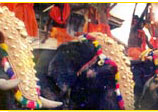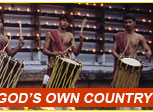





|
||
| Distict | ||
+ Thiruvananthapuram + Kollam + Pathanamthitta + Alappuzha + Kottayam + Idukki + Ernakulam + Thrissur + Palakkad + Malappuram + Kozhikode + Wayanad + Kannur + Kasargod |
||
| Travel Information | ||
+ Where To Dine |
||
| Prime Attractions | ||
| + Adventure in Kerala + Places of Worship + Kerala House Boats +Kerala Architecturall + Picnic Sport + Museum + Amusment Park + Dams + Tea Estate |
||
| Home ! Exotic Kerala ! Elephants of Kerala | |||
The Elephants of Kerala are an integral part of the daily life in Kerala, south India. They are loved, revered, groomed and given a prestigious place in the state's culturescape Unlike elephants in other parts of India, Kerala elephants are considered as very beautiful. People buy elephants looking for their laksnam (Qualities to be considered as a good elephant). For example the trunk should be long and touch the ground, the elephant should be very tall etc. :: Elephants in festivals Almost all of the festivals in Kerala include at least one richly caparisoned elephant. The elephants are decorated with gold plated caparisons, colourful umbrellas, alavattom, venchamaram, necklaces, etc. during the festivals. Many Hindu temples in Kerala keep elephants. Most of them are donated by devotees. For example the famous Guruvayur temple in Kerala has more than 40 domesticated elephants and they have constructed a sanctuary in Punnathur Kotta, 3 km from the temple for their elephants. One of the famous elephants named Guruvayur Keshavan was an elephant of this Guruvayur temple. Some famous festivals in Kerala are: ¤ Nemmara Vela ¤ Trichur Pooram :: Elephants in captivity Kerala has more than 700 elephants in captivity. Most of them are owned by temples and individuals. Some people are really 'crazed' to own an elephant. It is said that one person in central Kerala has 14 elephants in his 'collection'. They are used for religious ceremonies in and around the temples. A few elephants work at timber yards. :: Caring elephants Each elephant has three mahouts, called pappan in theMalayalam language. The most important duty of the mahouts is to bathe and massage the elephant with small rocks, and husk of coconuts. In the monsoon, the elephants undergo Ayurvedic rejuvenation treatments which include decoctions with herbs, etc. It is called Sukha Chikilsa in the Malayalam language. :: Ornaments used for elephants One of the famous families in Trichur district of Kerala called Venkitadri family have made ornaments for three generations, especially for the famous Thrissur pooram or festival. They make gold plated caparisons, umbrellas, alavattom, venchamaram, necklaces etc. They decorate 150 elephants with ornaments for temple festivals. : :Elephant Treatment and Elephant Taming ¤ HASTHYAAYURVEDAM "Paalakaapyam" is a treatise (Granthham) authored by Sage Paalakaapya. This work is better known as Hasthyaayurvedam (Encyclopaedia of Elephants and their Treatment). There were a few Namboothiris who had studied it and practised the techniques. Avanapparambu Narayanan Nambudiripad was perhaps the foremost in the treatment of elephants. He practised his knowledge till his death at 79 in ME 1119 (1943 - 44). His younger brother Godan (alias Anujan) was also an expert in this field, though he was better known for his extra-ordinary abilities in the treatment for toxicity ("Vishachikitsa"). The former was recognised by everyone as an authority on all matters concerning elephants. He had transferred his knowledge to many mahouts and turned them into experts on aspects like maintenance of elephants, and control of rogue elephants and those that have run amuck. Poomulli Neelakandhan Nambudiripad had studied Paalakaapyam and used to treat elephants, and so did Vaidyamadham Valiya Narayanan Namboodiri. The latter's grandson, Vaidyamadham Cheriya Narayanan Namboodiri (present Chief Physician of Vaidymadham Vaidysaala) has translated Paalakaapyam from Sanskrit to Malayalam. The Moosses of Pulamanthol family - late Sankaran (Kunjanujan) Mooss, his younger brother Aryan Mooss and their father - also used to treat elephants. ¤ ANAPPAAVU The term refers to the art of taming elephants, and not treatment. But one has to know everything regarding elephants - the vulnerable parts of their anatomy ("Marmams") (this is important in treatment too); climbing up on top of the elephants and getting down; understanding the signals that can be given by pressing the feet behind the ears; making elephants do different things through signals (expert mahouts need to know this); knowing the habits of rogue elephants so as to help to control them; taming those that have run amuck; use of the stick ("Vati"), hook ("Thotti") and long pole ("Valiya kol"); controlling the elephants frpm atop with the hook and stick to prevent being shaken down, etc. Elephants can gauge the caliber of new mahouts (or strangers) by the way the mahout climbs up, positions the stick and hook on the head and inserts the feet into the rope normally tied around the elephant's neck. "Aanappaavukaar" (taming-experts) should have some knowledge of elephant treatment too; and mahouts should know some Aanappaavu also. |
Copyright © 2004-14 Kerala Tourism All Rights Reserved. Privacy Policy and Terms of Use.
